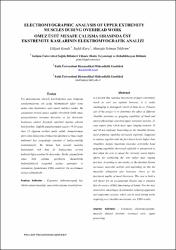| dc.contributor.author | Kınalı, Gülşah | |
| dc.contributor.author | Kara, Sadık | |
| dc.contributor.author | Yıldırım, Mustafa Selman | |
| dc.date.accessioned | 2019-01-19T22:19:59Z | |
| dc.date.available | 2019-01-19T22:19:59Z | |
| dc.date.issued | 2015 | |
| dc.identifier.isbn | 978-1-4673-7765-2 | |
| dc.identifier.uri | http://hdl.handle.net/11363/922 | |
| dc.description.abstract | It is known that repeated movements of upper extremities result in over use injuries however, it is really challenging to distinguish which of them do so. Primary aim of the project is to determine the effect of different shoulder positions on gripping capability of hand and electro physiologic activityof upper extremity muscles. 23 case report data which have ages ranging between 18 and 30 are analysed. Depending on the shoulder flexion, hand gripping capability decreased explicitly. Suggested to analyse together with the fact that at levels higher than shoulders, despite maximum muscular activitythe hand gripping capability decreased explicitly is interpreted so that when the arm is raised the extremity exerts higher efforts for stabilizing the arm rather than ripping function. According to our results, as the shoulder flexion increases, muscular activity and depending on this the muscular exhaustion also increases where as the functional quality of hand decreases. The case is both a risk factor for an occupational disease and a situation that decreases skillful functioning of hands. For the next researches, advantages of exhaustion reducing apparatus and ergonomic systems, which can be used during works requiring over shoulder movements, are EMG results. | en_US |
| dc.description.abstract | Üst ekstremitenin tekrarlı hareketlerinin aşırı kullanım yaralanmalarına yol açtığı bilinmektedir fakat buna neden olan hareketleri ayırt etmek oldukça zordur. Bu çalışmanın birincil amacı sağlıklı bireylerde farklı omuz pozisyonlarının kavrama kuvvetine ve üst ekstremite kaslarının elektro fizyolojik aktivitesi üzerine etkisini belirlemektir. Sağlıklı populasyondan yaşları 18-30 arası olan 23 olgunun verileri analiz edildi. Sonuçlarımıza göre omuz fleksiyonu arttıkça kas aktivitesi ve buna bağlı muhtemel kas yorgunluğu artarken el fonksiyonelliği azaltmaktaydı. Bu durum hem mesleki hastalık bakımından risk hem de fonksiyonun verimli kullanılırlığını azaltan bir durumdur. İleriki çalışmalarda omuz üstü çalışma gerektiren durumlarda kullanılabilecek yorgunluk azaltıcı aparatlar ve sistemlerin faydalarının EMG analizleri ile incelenmesi tavsiye edilmektedir. | en_US |
| dc.language.iso | tur | en_US |
| dc.publisher | IEEE, 345 E 47TH ST, NEW YORK, NY 10017 USA | en_US |
| dc.rights | info:eu-repo/semantics/openAccess | en_US |
| dc.rights | Attribution-NonCommercial-NoDerivs 3.0 United States | * |
| dc.rights.uri | http://creativecommons.org/licenses/by-nc-nd/3.0/us/ | * |
| dc.subject | Research Subject Categories::MEDICINE::Surgery::Surgical research::Orthopaedics | en_US |
| dc.subject | Research Subject Categories::TECHNOLOGY::Industrial engineering and economy::Manufacturing engineering and work sciences::Work sciences and ergonomics | en_US |
| dc.subject | Research Subject Categories::TECHNOLOGY::Information technology::Signal processing | en_US |
| dc.title | Omuz Üstü Mesafe Çalışma Sırasında Üst Ekstremite Kaslarının Elektromyografik Analizi | en_US |
| dc.title.alternative | Electromyographic Analysis of Upper Extremity Muscles During Overhead Work | en_US |
| dc.type | conferenceObject | en_US |
| dc.relation.ispartof | Medical Technologies National Conference (TIPTEKNO) | en_US |
| dc.department | İstanbul Gelişim Üniversitesi | en_US |
| dc.relation.publicationcategory | Kategori Yok | en_US |



















